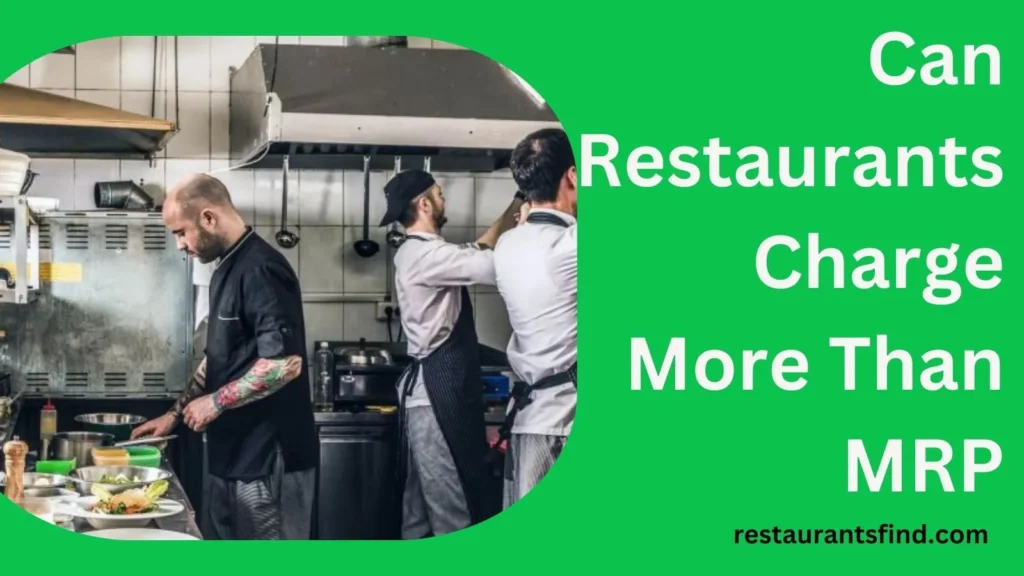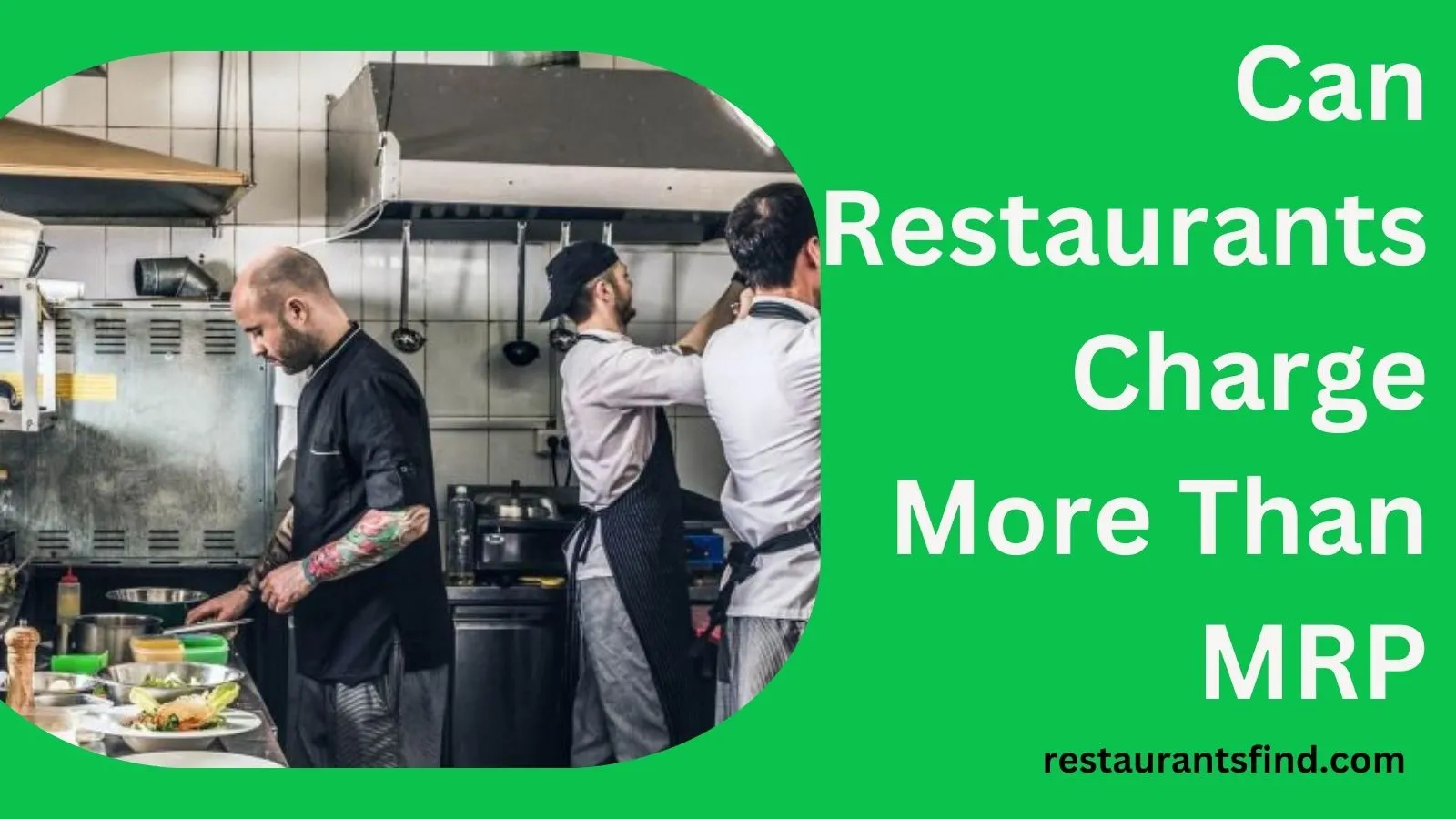Have you ever wondered why some restaurants charge more than the maximum retail price (MRP) for packaged products like water bottles, soft drinks, or snacks? Is it legal for them to do so? How do they decide their prices? In this blog post, we will explore these questions and more.

What is MRP?
MRP, or maximum retail price, is the highest amount a retailer can ask for a product. The manufacturer or importer mentions it on the product label and covers all taxes and charges. The idea behind MRP is to safeguard consumers from being charged too much by retailers and to maintain consistent pricing nationwide.
People usually anticipate paying the MRP or less when buying something from a store. If they’re asked to pay more, especially for crucial items like water or food, they might feel deceived or taken advantage of.
Can Restaurants Charge More Than MRP?
Yes, restaurants can charge more than the price written on products (MRP). Unlike stores, restaurants are seen as service providers. They don’t just sell items but also provide services like cooking and serving. So, they’re not restricted by MRP rules and can set prices above the MRP, as long as they tell customers about it.
However, this doesn’t mean they can charge extremely high prices. They have to think about things like ingredient costs, running the restaurant, location, the people they serve, and the quality of service and atmosphere.
They also need to follow laws like the Consumer Protection Act to make sure they’re treating customers fairly and following the rules.
Factors Influencing Restaurant Pricing
Cost of Ingredients and Preparation:
The price of a dish depends on how much it costs to get the ingredients and prepare the food. Restaurants get their ingredients from different suppliers and have expenses like transportation, storage, and dealing with waste.
They also have to cover labor, equipment, and utility costs. The overall cost can change based on things like the season, availability, and quality of the products.
Operational Expenses and Overhead Costs:
The cost of running a restaurant, including rent, taxes, licenses, insurance, maintenance, and marketing, affects the pricing of dishes. These expenses can vary depending on the restaurant’s size, location, and type.
Location and Target Market:
Where a restaurant is located and the kind of customers it wants to attract influence its pricing. Restaurants in popular areas might charge more to cover higher rent and attract more customers.
Different types of restaurants, like fine dining or fast food, may also set different prices based on what their target customers expect.
Quality of Service and Ambiance:
How well a restaurant serves customers and the overall atmosphere it provides play a role in pricing. Restaurants with excellent service, including friendly staff and timely delivery, might charge more than those with average or poor service.
The ambiance, created through things like music, lighting, decor, and cleanliness, can also impact prices, with places offering a more pleasant environment charging higher.
Read: Can Restaurants Charge a Service Charge?
Legal Considerations and Exceptions
While restaurants have the flexibility to set prices beyond the MRP for packaged items, they must adhere to legal and ethical guidelines, including certain exceptions.
Consumer Protection Act and Pricing Regulations
The Consumer Protection Act of 2019 is the primary law governing the rights and responsibilities of consumers and service providers in India. It prohibits unfair trade practices, such as deceptive advertising, false claims, substandard products, and inadequate services.
The Act establishes consumer courts where individuals can file complaints and seek resolution for grievances. Besides the Consumer Protection Act, other laws and regulations address pricing matters, including the Legal Metrology Act of 2009, the Food Safety and Standards Act of 2006, and the Goods and Services Tax Act of 2017.
These laws prescribe standards, rules, and procedures for measuring, labeling, packaging, and taxing of products and services.
Restaurants are obligated to comply with these laws and regulations, clearly and accurately displaying prices on menus, bills, and boards. They must also issue proper invoices and receipts, ensuring the payment of applicable taxes and fees to the government.
Menu Transparency and Disclosure
A crucial aspect of pricing is transparency and disclosure. Restaurants must openly and honestly communicate their prices, revealing any additional charges or fees to customers.
For instance, if a restaurant charges more than the MRP for a packaged product, it should mention it on the menu or bill and inform the customer before serving.
Similarly, if a restaurant imposes service charges, delivery charges, or convenience fees, it must disclose these to the customer and obtain their consent.
Circumstances Allowing Deviation from MRP
Certain circumstances allow restaurants to deviate from the MRP for packaged products, such as: • If the product is part of a composite service, like a buffet, combo, or package, where the customer pays a fixed price for a variety of products and services. • If the product is part of a value-added service, like a customized or personalized product, where the customer pays extra for additional features or benefits. • If the product is part of a promotional offer, like a discount, coupon, or loyalty program, where the customer pays less than the MRP for the product.
In such cases, the restaurant must clearly communicate the terms and conditions of the offer and ensure that the customer is aware of and agrees to it.
Consequences for Violations
If a restaurant breaches pricing laws or engages in unfair trade practices, it may face legal repercussions and penalties from authorities, such as consumer courts, the legal metrology department, the food safety department, or the tax department.
Penalties could include fines, imprisonment, license cancellation, or product seizure. Additionally, violating consumer rights or expectations may result in negative consequences from customers, such as complaints, boycotts, unfavorable reviews, or damage to reputation.
Therefore, it is in the restaurant’s best interest to comply with pricing laws and regulations, maintain a positive relationship with customers, and balance consumer expectations with business sustainability.
This approach fosters transparency and ethics in pricing, ensuring customer satisfaction, loyalty, and avoidance of legal issues and penalties.
For instance, in 2014, Bhaskar Jadhav, a Mumbai police officer, purchased an ice-cream brick for his daughter from Shagun Veg Restaurant in Mumbai Central. Despite the MRP being Rs 165, he was charged Rs 175 for the ice cream. Upon questioning the restaurant staff, they justified the additional Rs 10 as ‘cooling charges.’ Bhaskar, refusing to pay the extra amount, engaged in a heated argument. Eventually, he decided to file a case against the restaurant in the consumer forum, with the support of activist Prakash Sheth.
The legal battle extended over five years, concluding in 2020 when the District Consumer Disputes Redressal Forum ruled in favor of Bhaskar. The forum mandated the restaurant to pay a fine of Rs 2 lakh to the Consumer Welfare Fund, Rs 10,000 to Bhaskar as compensation for mental distress, and Rs 10 as a refund for the unjust cooling charge. Additionally, the forum observed that the restaurant had violated the Legal Metrology Act, 2009, and the Consumer Protection Act, 1986, by exceeding the MRP and failing to display prices transparently.
Read: Zomato Delivery Charges: Everything You Need to Know
Conclusion
In summary, restaurants, as service providers, have the flexibility to charge more than the MRP for packaged products, given they inform customers and adhere to pricing laws.
However, they must consider factors like ingredient costs, operational expenses, location, and service quality. Balancing consumer expectations and business sustainability while maintaining transparency and ethics is crucial.
This approach fosters customer satisfaction and loyalty, helping restaurants avoid legal issues and penalties.

